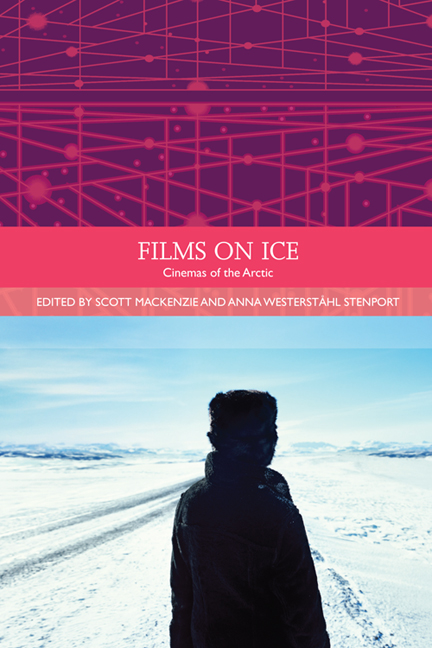Book contents
- Frontmatter
- Contents
- List of Illustrations
- Acknowledgements
- Traditions in World Cinema
- Introduction: What are Arctic Cinemas?
- PART I GLOBAL INDIGENEITY
- PART II HOLLYWOOD HEGEMONY
- PART III ETHNOGRAPHY AND THE DOCUMENTARY DILEMMA
- PART IV MYTHS AND MODES OF EXPLORATION
- 20 The Changing Polar Films: Silent Films from Arctic Exploration 1900–30
- 21 The Attractions of the North: Early Film Expeditions to the Exotic Snowscape
- 22 Frozen in Motion: Ethnographic Representation in Donald B. MacMillan's Arctic Films
- 23 ‘My Heart Beat for the Wilderness’: Isobel Wylie Hutchison, Jenny Gilbertson, Margaret Tait and Other Twentieth-Century Scottish Women Filmmakers
- 24 ‘Here will be a Garden-City’: Soviet Man on an Arctic Construction Site
- 25 Transcending the Sublime: Arctic Creolisation in the Works of Isaac Julien and John Akomfrah
- 26 DJ Spooky and Dziga Vertov: Experimental Cinema Meets Digital Art in Exploring the Polar Regions
- Notes on the Contributors
- Index
26 - DJ Spooky and Dziga Vertov: Experimental Cinema Meets Digital Art in Exploring the Polar Regions
from PART IV - MYTHS AND MODES OF EXPLORATION
Published online by Cambridge University Press: 05 September 2016
- Frontmatter
- Contents
- List of Illustrations
- Acknowledgements
- Traditions in World Cinema
- Introduction: What are Arctic Cinemas?
- PART I GLOBAL INDIGENEITY
- PART II HOLLYWOOD HEGEMONY
- PART III ETHNOGRAPHY AND THE DOCUMENTARY DILEMMA
- PART IV MYTHS AND MODES OF EXPLORATION
- 20 The Changing Polar Films: Silent Films from Arctic Exploration 1900–30
- 21 The Attractions of the North: Early Film Expeditions to the Exotic Snowscape
- 22 Frozen in Motion: Ethnographic Representation in Donald B. MacMillan's Arctic Films
- 23 ‘My Heart Beat for the Wilderness’: Isobel Wylie Hutchison, Jenny Gilbertson, Margaret Tait and Other Twentieth-Century Scottish Women Filmmakers
- 24 ‘Here will be a Garden-City’: Soviet Man on an Arctic Construction Site
- 25 Transcending the Sublime: Arctic Creolisation in the Works of Isaac Julien and John Akomfrah
- 26 DJ Spooky and Dziga Vertov: Experimental Cinema Meets Digital Art in Exploring the Polar Regions
- Notes on the Contributors
- Index
Summary
Paul D. Miller, also known as DJ Spooky That Subliminal Kid, is a multimedia artist, musician and writer who performed a Kino-Glaz/Kino-Pravda remix at the Tate Modern in London. Kino-Glaz/Kino-Pravda (which could be translated from Russian as ‘The Cinema Eye/The Cinema Truth’) is a remix based on a newsreel series, The Cinema Truth (Kinopravda, 23 issues, 1922–5), and a documentary film, The Cinema Eye (Kinoglaz, 1924), directed by the Soviet filmmaker Dziga Vertov.
A joyful reception of the KinoGlaz/Kino-Pravda remix across the globe would probably please Vertov, whose experiments in montage earned him the status of a pioneer of digital media. Although his films received an extremely hostile reception back in the 1930s, as soon as new media emerged and scholars began researching the continuity between traditional and digital art, Vertov was rediscovered and glorified as one of the most significant artists presaging future media and database culture. To list just a few examples, Vertov has been credited with the inception of surveillance photography, with the development of contemporary open-source and user-generated practices, with the invention of the 360-degree camera that is used in video games, and digital compositing. New media scholar Lev Manovich describes Vertov's work as ‘the most important example of a database imagination in modern media art’ (Manovich 2001: 239), while Paul D. Miller refers to Vertov as ‘the first YouTube director’, ‘the Photoshop director’, and ‘the first collage multimedia director’ (Miller 2012).
In 2007, Paul D. Miller launched a multimedia and multidisciplinary project dedicated to the investigation of polar culture. In 2008, he chartered a decommissioned Soviet military icebreaker, Akademik Ioffe, and went to Antarctica to work on the first part of his polar project. This became the multimedia symphony Terra Nova: Sinfonia Antarctica. Since 2008, it has been performed at galleries, theatres, universities and festivals around the world. A companion volume, The Book of Ice, was released in 2011. Miller is currently collecting materials for the second part of his polar series, Arctic Rhythms: Ice Music. He went to the North Pole in 2010, but says that this project is going to take some time to finish because ‘a bigger population of the Arctic makes for a different project’ (Hoffmann 2011: 279).
- Type
- Chapter
- Information
- Films on IceCinemas of the Arctic, pp. 335 - 348Publisher: Edinburgh University PressPrint publication year: 2014



